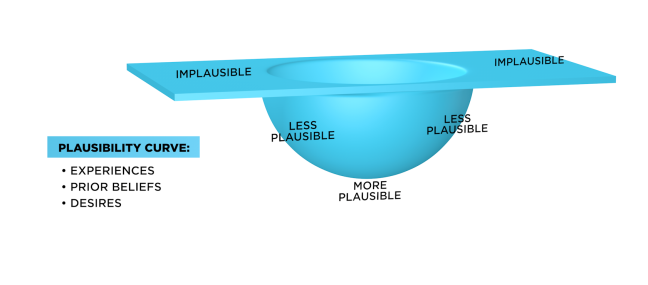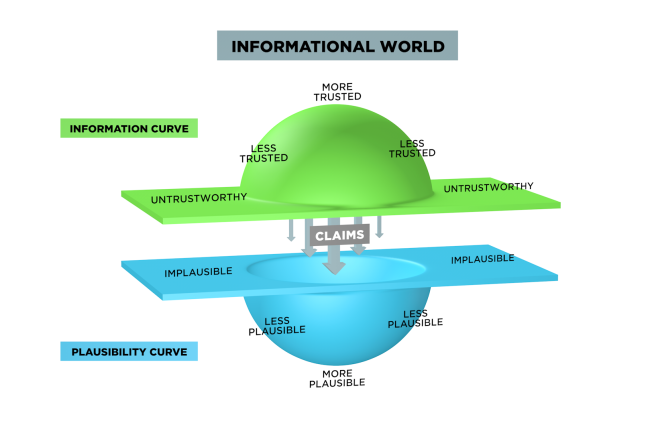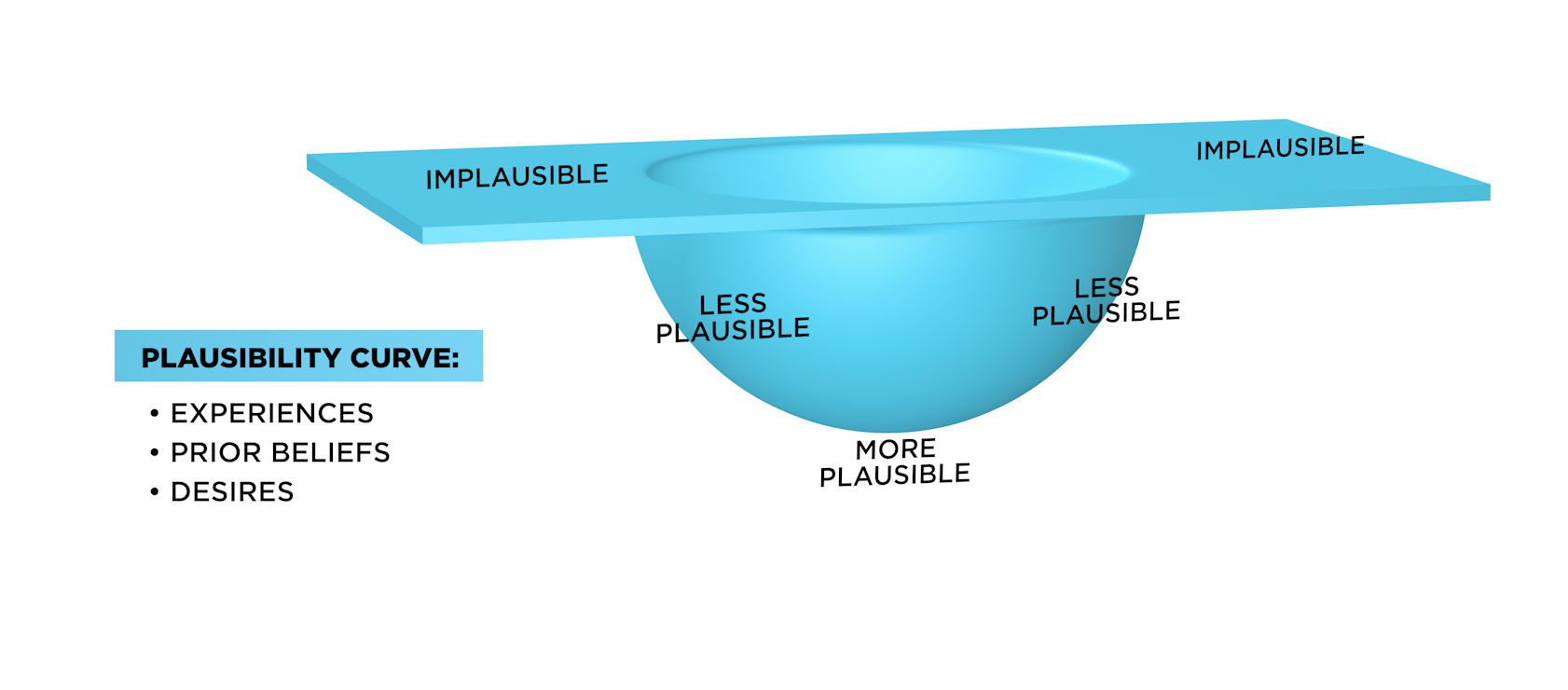New fractures are forming within the American evangelical movement, fractures that do not run along the usual regional, denominational, ethnic, or political lines. Couples, families, friends, and congregations once united in their commitment to Christ are now dividing over seemingly irreconcilable views of the world. In fact, they are not merely dividing but becoming incomprehensible to one another.
Recently, a group of my college friends, all raised and nurtured in healthy evangelical families and congregations, reconnected online in search of understanding. One person mourned that she could no longer understand her parents or how their views of the world had so suddenly and painfully shifted. Another described friends who were demographically identical, who had once stood beside him on practically every issue, but who now promoted ideas he found shocking. Still another said her church was breaking up, driven apart by mutual suspicion and misunderstanding.
“These were my people,” one said, “but now I don’t know who they are, or maybe I don’t know who I am.”
What do you do when you feel you’re losing the people you love to a false reality? What do you do with the humbling truth that they have precisely the same fear about you?
The quandary is not unique to evangelicals. But fellow believers who once stood shoulder to shoulder now find that tectonic shifts have thrust them apart, their continents are separating, and they cannot find a bridge back to common ground. How could our views of reality diverge so dramatically—and is there anything we can do to draw together again?
The plausibility curve and the information curve
Among the most persistent interests of my academic career was the question of how people form beliefs. Not how they should form beliefs, in some idealized vision of perfected rationality, but how they actually form beliefs as embodied creatures embedded in communities and cultures. I want to introduce a simple conceptual tool, influenced in part by the work of Peter Berger, that may help us understand what is happening.
Imagine a horizontal plane that curves downward into a bowl, rises back again, and returns to a horizontal plane. The curve, from one end of the bowl to the other, represents the range of claims an individual finds believable. Let’s call it a plausibility curve. Claims that fall in the center of the curve will be perceived as most plausible; they require little evidence or argumentation before an individual will consent to believe. Claims falling near the edges are increasingly implausible as they deviate from the center, requiring progressively more persuasion. Claims falling entirely outside the plausibility curve are beyond the range of what a person might believe at a given point in time, and no amount of evidence or logic will be sufficient.

What determines the plausibility of a given claim is how well it conforms to what an individual experiences, already believes, and wants to believe. The full range of a person’s beliefs is rather like a photomosaic (see an example here): Thousands of experiences and perceptions of reality are joined together, and out of those thousands emerge larger patterns and impressions, higher-order beliefs about the nature of reality, the grand narratives of history, the nature of right and wrong, good and evil, and so forth. Attempts to change a single belief can feel fruitless when it is embedded in countless others. Where does one begin to address a thousand interlocking disagreements at once? Evidence to the contrary is almost irrelevant when a claim “fits” with an entire network of reinforcing beliefs. This is part of what gives a plausibility curve its enduring strength and resistance to change.
Desire plays a particularly complicated role in the plausibility curve. We may desire not to believe a claim because it would separate us from those we love, confront us with painful truths, require a change in our behavior, impose a social cost, or so on. We may desire to believe a certain claim because it would be fashionable, confirm our prejudices, set us apart from those around us, anger our parents, or for countless other reasons. We will require more persuasion for claims we do not want to believe, and less for those we do.
Like the Overton window in political theory, a plausibility curve can expand, contract, and shift. Friends or family members whose plausibility curves were once identical may find that they diverge over the course of time. Claims one person finds immediately plausible are almost inconceivable to the other. But how does this happen? That’s where the information curve comes in.
Imagine a mirror-image bowl above the plausibility curve. This is the information curve, and it reflects the individual’s external sources of information about the world—such as communities, authorities, and media. Those sources in the center of the information curve are deemed most trustworthy; claims that come from these sources are accepted almost without question. Sources of information on the outer ends of the bowl are considered less trustworthy, so their claims will be held up to greater scrutiny. Sources outside the curve entirely are, at least for this individual, so lacking in credibility that their claims are dismissed out of hand.

The center of the information curve will generally align with the center of the plausibility curve. The relationship is mutually reinforcing. Sources are considered more trustworthy when they deliver claims we find plausible, and claims are considered more plausible when they come from sources we trust. A source of information that consistently delivers claims in the center of the plausibility curve will come to be believed implicitly.
Change can begin on the level of the plausibility curve. Perhaps an individual joins a religious community and finds it is more loving and reasonable than she had expected. She will no longer find it plausible when a source claims that all religious communities are irrational and prejudiced, and this will gradually shift her information curve in favor of more reliable sources. Or another person experiences the loss of a child, and no longer desires to believe that death is the end of consciousness. He is more open to other claims, expands his sources of information, and slowly his beliefs shift.
Change can also begin on the level of the information curve. An individual raised in a certain community with well-established authorities, such as her parents and pastors, goes to college and is introduced to new communities and authorities. If she judges them to be trustworthy sources of information, this new information curve will likely shift her plausibility curve. As her set of beliefs changes, she may even reach a point where the sources that once supplied most of her beliefs are no longer considered trustworthy at all. Or imagine a person who has lived his entire life consuming far-left media sources. He begins to listen to conservative media sources and finds their claims resonate with his experience—only slightly at first, but in increasing measure. Gradually he consumes more and more conservative media, expanding or shifting his information curve, and this in turn expands or shifts his plausibility curve. He may reach a point where his broader perceptions of the world—the deeper forces at work in history, the optimal ways of organizing societies and economies, the forces for good and evil in the world—have been wholly overturned.

Consider the 9/11 Truth movement and the QAnon movement. Most Americans will find the notion that the Bush administration orchestrated a massive terrorist attack in order to invade the Middle East and enrich their friends in the oil industry, or that global liberal elites would construct an international child trafficking operation for the purpose of pedophilia and cannibalism, beyond the bounds of their plausibility curve. Others, however, will find that one conspiracy or the other resonates with their plausibility curve, or their information curve may shift over time in such a way that brings their plausibility curve with it. Claims that once seemed impossible to contemplate came to appear conceivable, then plausible, then reasonable, and finally self-evident. Of course conservatives would sacrifice thousands of innocent lives to justify a “war for oil” because conservatives are greedy and that’s what conservatives do. Of course liberals would sacrifice thousands of children in order to advance their own health and power because liberals are perverse and that’s what liberals do.
As a final definitional note, let’s call the whole structure, the plausibility curve and the information curve, an informational world. An informational world encompasses how an individual or a community of individuals receives and processes information. Differing informational worlds will have differing facts and sources. Our challenge today is that we occupy multiple informational worlds with little in common and much hostility between them.
What does all of this have to do with the evangelical movement? A great deal.
The evangelical crises
The American evangelical movement has never been comprised of a single community. Depending on the criteria, estimates generally put the number of American evangelicals at 80-100 million. Even if we split the difference at 90 million, this would make the American evangelical population larger than every European nation save Russia. It is also diverse, reaching across all regions, races, and socioeconomic levels. What held the movement together historically was not only a shared set of moral and theological commitments, but a broadly similar view of the world and common sources of information. Their plausibility curves and information curves largely overlapped. There were some matters on which they differed, but the ground they shared in the middle served as a basis of mutual understanding and fellowship.
This sense of commonality grew increasingly strained as groups not formerly identified as evangelical came to be lumped together, defining the category “evangelical” less in theological terms and more in social, cultural, and political terms. This broader evangelical movement today is dividing into separate communities that still hold some moral and theological commitments in common but differ dramatically on their sources of information and their broader view of the world. Their informational worlds have little overlap. They can only discuss a narrow range of topics if they do not want to fall into painful and exasperated disagreement.
One group within American evangelicalism believes our religious liberties have never been more firmly established; another that they have never been at greater risk. One group believes racism is still systemic in American society; another that the “systemic racism” push is a progressive program to redistribute wealth and power to angry radicals. One is more concerned with the insurrection at the Capitol; another with the riots that followed the killing of George Floyd. One believes the Trump presidency was generationally damaging to Christian witness; another that it was enormously beneficial. One believes the former president attempted a coup; another that the Democrats stole the election. One believes masks and vaccines are marks of Christian love; another that the rejection of the same is a mark of Christian courage.
There are countless groups in between, of course, but these examples illustrate the tension: We occupy the same reality but starkly different worlds. There is a real question whether these worlds can (or should) draw back together again. This is a critical moment for our movement.
What, then, can be done? The model itself suggests where to start. If we move the information curves toward a common center, the plausibility curve will follow. Information comes through three sources: media, authorities, and community. One reason for our disunity is that these three sources are in crisis in American evangelicalism. I will only briefly outline these points.
First, the crisis of media is acute. Even as media today has grown more powerful and pervasive, it has also grown more fragmented and polarizing. The dynamics of modern media reward content that is immediate, angry, and hyperbolic, rendering the media into a marketplace for scorn sellers and hate merchants. Evangelicals find themselves torn between social media platforms and legacy media sources that openly advocate progressive causes and cancel conservative voices and far-right sources that traffic in paranoia and misinformation. In short, the digital media landscape has evolved to profit from our vices more than our virtues, and it has become incredibly effective at dividing audiences into hermetic media spheres that deliver only the information and commentary that confirms the audiences’ anxieties and antipathies.
This presents an extraordinary challenge for Christian discipleship. Media consumption has been climbing for years, and it soared amid the pandemic. Members of our congregations may spend a few hours a week in the Word of God (which should always be the Christian’s most important source of information and authority) but 40 hours or more mainlining the animosities of the day. Once the information curve begins a leftward or rightward drift, the algorithms of digital media and the manipulations of politicians and profiteers accelerate the momentum. Soon Christian communities that once shared a broader view of the world find they only agree on the bare essentials of faith. It will be difficult to address other parts of the information curve until we have brought some semblance of sanity into our media consumption. The longer we live in separate media worlds, the deeper and broader our divisions will become. The longer we give ourselves to media gluttony, skimping on the deeper nourishment that cultivates Christ within us, the less we will have in common.
The media crisis reaches across the whole of society, but the evangelical movement also faces an authority crisis of its own making. A generation of evangelical leaders who commanded immense respect, at least across the broad middle of American evangelicalism, have passed away. The current generation of evangelical institutional leaders, though markedly more diverse than their forebears, struggle to rise above the rampant ideological othering of our time. Moreover, the movement has seen countless leaders fall from grace in spectacularly destructive ways. At the same time, we have seen the rise of the celebrity pastor. It was once the case that a long obedience in the same direction, a life of humble study and service, earned a person a modicum of spiritual authority and a modest living. Today, a dashing profile and a talent for self-promotion can earn wealth and stardom in the Christian celebrity marketplace.
The consequence is disillusionment and division. While younger generations head for the exits, those who remain in our churches become further entrenched in their own ideological camps. If it is ever to be true again that broadly respected authorities form an important part of our shared information curve, it will be because we turn from a culture of celebrity to a culture of sanctification, where leadership is less about building a platform and more about carrying the cross of Christ. It will be because we remember the words of Jesus that “whoever wants to become great among you must be your servant” (Matt. 20:26). It will also be because we relearn how to listen to men and women of wisdom, leaders as well as neighbors, without crucifying them over political differences.
The third way to shift the information curve is to address our crisis of community. Community is essential to Christian life. It deepens our knowledge of the Word, forges our shared identity in Christ, cultivates Christian character, and disciples our young. Yet the pressures, temptations, and glowing distractions of contemporary life have strained the ties that bind us, replacing the warmth and depth of incarnate community with a cold digital imitation. The pandemic has only deepened our isolation, causing many to look outside their churches to political tribes or conspiracist communities for a sense of purpose and belonging. Further, the hyper-politicization of the American evangelical movement has led to a political sorting. Congregants who do not like their pastors’ stances depart for other churches whose politics are the same as theirs. But congregations comprised of individuals whose informational worlds are nearly identical will tend toward rigidity and increasing radicalism—what Cass Sunstein calls the Law of Group Polarization.
Rather than withdrawing into communities of common loathing, the church should be offering a community of common love, a sanctuary from the fragmentation and polarization, from the loneliness and isolation of the present moment. The church should model what it means to care for one another in spite of our differences on social and political matters and affirm the incomparably deeper rootedness of our identity in Christ.
Michael O. Emerson, a sociologist and scholar of American religion at the University of Illinois at Chicago, recently said he has studied religious congregations for 30 years but has “never seen” such an extraordinary level of conflict. “What is different now?” he asked. “The conflict is over entire worldviews—politics, race, how we are to be in the world, and even what religion and faith are for.” What I have offered above is a model for understanding how we have come to such a pass, and a mere suggestion of how we might begin the generational project before us.
We are not without hope. Lies ring hollow at the end of the day. Hatred is a poor imitation of purpose, celebrity a poor replacement for wisdom, and political tribes a poor comparison to authentic Christian community. We are a people defined by the resurrection of the Son of God. We are called to be redeemers and reconcilers.
So perhaps we can begin to build bridges across our informational worlds. Perhaps we can nurture a healthy media ecosystem that offers a balanced view of the world and a generous conversation about it. Perhaps we can restore a culture of leadership defined by humility over celebrity and integrity over influence. Perhaps we can invite those who have found counterfeit community in their political tribes to rediscover a richer and more robust community in Christ. All of these things will be essential to rebuilding a shared understanding of the world God created and what it means to follow Christ within it.
Timothy Dalrymple is president and CEO of Christianity Today. Follow him on Twitter @TimDalrymple_.












